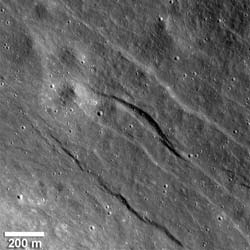NASA spacecraft reveals recent geological activity on the moon

This shows the largest of the newly detected graben found in highlands of the lunar farside. The broadest graben is about 500 meters (1,640 feet) wide and topography derived from Lunar Reconnaissance Orbiter Camera (LROC) Narrow Angle Camera (NAC) stereo images indicates they are almost 20 meters (almost 66 feet) deep. Credit: (Credit: NASA/Goddard/Arizona State University/Smithsonian Institution<br>
A team of researchers analyzing high-resolution images obtained by the Lunar Reconnaissance Orbiter Camera (LROC) show small, narrow trenches typically much longer than they are wide. This indicates the lunar crust is being pulled apart at these locations. These linear valleys, known as graben, form when the moon's crust stretches, breaks and drops down along two bounding faults. A handful of these graben systems have been found across the lunar surface.
“We think the moon is in a general state of global contraction because of cooling of a still hot interior,” said Thomas Watters of the Center for Earth and Planetary Studies at the Smithsonian's National Air and Space Museum in Washington, and lead author of a paper on this research appearing in the March issue of the journal Nature Geoscience. “The graben tell us forces acting to shrink the moon were overcome in places by forces acting to pull it apart. This means the contractional forces shrinking the moon cannot be large, or the small graben might never form.”
The weak contraction suggests that the moon, unlike the terrestrial planets, did not completely melt in the very early stages of its evolution. Rather, observations support an alternative view that only the moon's exterior initially melted forming an ocean of molten rock.
In August 2010, the team used LROC images to identify physical signs of contraction on the lunar surface, in the form of lobe-shaped cliffs known as lobate scarps. The scarps are evidence the moon shrank globally in the geologically recent past and might still be shrinking today. The team saw these scarps widely distributed across the moon and concluded it was shrinking as the interior slowly cooled.
Based on the size of the scarps, it is estimated that the distance between the moon's center and its surface shank by approximately 300 feet. The graben were an unexpected discovery and the images provide contradictory evidence that the regions of the lunar crust are also being pulled apart.
“This pulling apart tells us the moon is still active,” said Richard Vondrak, LRO Project Scientist at NASA's Goddard Space Flight Center in Greenbelt, Md. “LRO gives us a detailed look at that process.”
As the LRO mission progresses and coverage increases, scientists will have a better picture of how common these young graben are and what other types of tectonic features are nearby. The graben systems the team finds may help scientists refine the state of stress in the lunar crust.
“It was a big surprise when I spotted graben in the far side highlands,” said co-author Mark Robinson of the School of Earth and Space Exploration at Arizona State University, principal investigator of LROC. “I immediately targeted the area for high-resolution stereo images so we could create a three-dimensional view of the graben. It's exciting when you discover something totally unexpected and only about half the lunar surface has been imaged in high resolution. There is much more of the moon to be explored.”
The research was funded by the LRO mission, currently under NASA's Science Mission Directorate at NASA Headquarters in Washington. LRO is managed by NASA's Goddard Space Flight Center in Greenbelt, Md.
Media Contact
More Information:
http://www.nasa.govAll latest news from the category: Earth Sciences
Earth Sciences (also referred to as Geosciences), which deals with basic issues surrounding our planet, plays a vital role in the area of energy and raw materials supply.
Earth Sciences comprises subjects such as geology, geography, geological informatics, paleontology, mineralogy, petrography, crystallography, geophysics, geodesy, glaciology, cartography, photogrammetry, meteorology and seismology, early-warning systems, earthquake research and polar research.
Newest articles

High-energy-density aqueous battery based on halogen multi-electron transfer
Traditional non-aqueous lithium-ion batteries have a high energy density, but their safety is compromised due to the flammable organic electrolytes they utilize. Aqueous batteries use water as the solvent for…

First-ever combined heart pump and pig kidney transplant
…gives new hope to patient with terminal illness. Surgeons at NYU Langone Health performed the first-ever combined mechanical heart pump and gene-edited pig kidney transplant surgery in a 54-year-old woman…

Biophysics: Testing how well biomarkers work
LMU researchers have developed a method to determine how reliably target proteins can be labeled using super-resolution fluorescence microscopy. Modern microscopy techniques make it possible to examine the inner workings…





















